
The Stories Behind Seven of the Worst Massacres in Ancient History
We all know that the ancient world was a violent place, but we often don’t appreciate just how violent it was. The world was in a near-constant state of bloodshed and warfare. Massacres and mass slaughter were practically a part of daily life. The numbers killed in these ancient conflicts, and the reasons given for them, can boggle the mind. Here are seven of the worst massacres carried out in ancient history.
1. The Extermination of the Jie and Wu Hu in Ancient China
In fourth-century AD China, a war broke out when the Jie and Wu Hu peoples rebelled against the rule of General Ran Min. The war did not go well for the Jie or Wu Hu, and Ran Min ensured an example was made of them.
Things came to a head with Ran Min’s victory at the Battle of Xiangguo. At the beginning of the war, Ran Min had ordered that all Jie people be exterminated. For attempting to help the Jie, the Wu Hu were given the same fate. Ran Min declared that all Jie and Wu Hu must be killed indiscriminately, regardless of they were male, female, young, or old.
Following their victory at Xiangguo, Ran Min’s army swept into Jie and Wu Hu lands, carrying out Ran Mins’s terrible order. Farms, villages, and entire towns were raided and put to death. Wu Hu and Jie refugees fled to the larger cities, hoping to hide in the crowds. Citizens loyal to Ran Min delighted in hunting down those refugees and murdering them.
Ultimately, many of the Wu Hu fled to Mongolia and the far corners of Asia where they were safe. Still, estimates put the Wu Hu death toll at around 100,000. The Jie fared even worse. They faced almost total genocide and were virtually wiped out. During the war and the ensuing massacres that followed, at least 200,000 Jie were butchered. The corpses were rounded up and dumped in mass graves.
Ran Min was overjoyed. He declared the total eradication of the Jie people. Subsequent Chinese history suggests this may have been premature. Later sources contain references that hint some Jie may have somehow managed to survive the genocide. Survivors or not, this was one of the worst massacres in history.
- Was the Mohenjo Daro ‘Massacre’ Real?
- Archaeologists Discover Tollense Battle Was Actually A Massacre
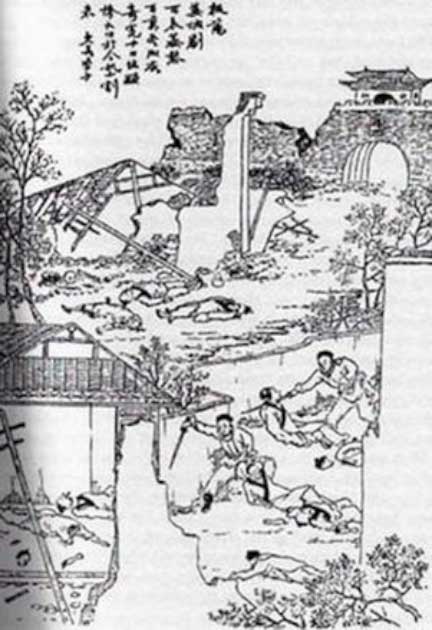
General Ran Min’s genocide of the Wu Hu and Jie peoples in the fourth century was nearly complete (Public Domain)
2. The Thessalonica Massacre: From Sodomy to Bloodshed
There is a common misconception that the ancient Greeks and Romans were fine with homosexuality. This is not accurate. There were strict societal rules in place regarding sodomy, and dire consequences for those who broke them.
In 390 AD, the magistrate of Illyricum, an area including Thessalonica, had a local celebrity arrested. His crime? An alleged act of sodomy with another high-ranking man.
It was clearly a political move and the public was outraged. They demanded the men be released. The magistrate, Butheric, stuck to his guns and refused. The public responded by protesting. The protests in Thessalonica turned into riots, and the riots turned into anarchy. In the ensuing chaos, Butheric and several other Roman officials in the city and neighboring regions were killed by the mob.
The news quickly reached the ears of the Roman Emperor Theodosius I. The Romans could not afford to let any kind of unrest, let alone the murder of government representatives, go unpunished. The emperor ordered that troops be dispatched immediately with orders to deal with these rebels harshly.
Harshly may be an understatement. His original order was to treat everyone within the city as if they were guilty. No one was to be spared. Every man, woman, and child was to be executed without exception.
Theodosius quickly second-guessed himself, realizing that he may have gone a little overboard. As his troops approached the city, he sent a messenger to head them off. His new orders were to arrest the ringleaders but to leave the citizens alone. He was too late.
By the time his messenger had entered the city, it was all for naught. The troops had gone in and carried out their original orders. Several thousand innocent people had been slaughtered in the name of the Roman emperor. Church officials were outraged by the massacre. Theodosius was banned from entering any Christian church until he agreed to make changes to Roman law that would prevent a repeat of the massacre.
Theodosius consented and brought in a new law that anyone sentenced to death be granted 30 days before their execution. Historians believe around 7,000 people were massacred in Thessalonica.
- Prehistoric Spanish Massacre Rewrites the History of War in Europe
- 6,200-Year-Old Croatian Massacre Solved With Genetic DNA Study
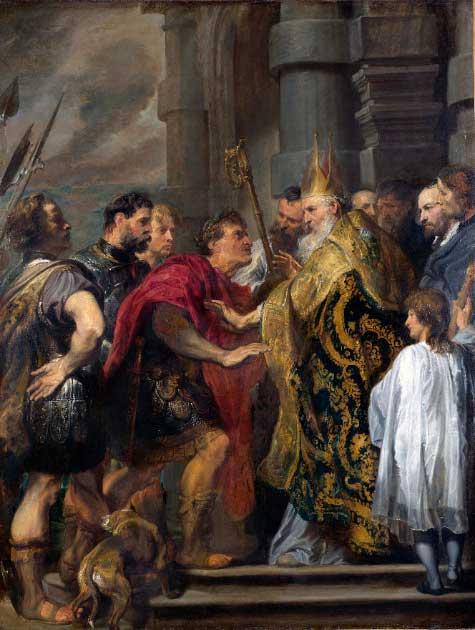
Anthonis Van Dyke's 1619 painting of St. Ambrose blocking the cathedral door, refusing Theodosius' admittance. Saint Ambrose barring Theodosius from Milan Cathedral (Public Domain)
3. The Massacre of the Zoroastrians at Istakhr
Istakhr was an ancient Persian city that thrived during the Achaemenid Persian Empire of 550-330 BC. Located in what is modern-day Iran, it emerged at the end of a caravan road that connected to the city of Persepolis and the wealthy Indus Valley. Istakhr thrived as a trade hub, for a while.
In 649 AD, Muslim Arabs invaded and took control of the city. The city's new rulers brought in strict new rules. These included the repression of Zoroastrianism, a peaceful local religion, and support of Islam. For two years, the people of the city suffered under Arab rule and persecution. Eventually, enough was enough, and they revolted. This Persian rebellion did not go to plan.
The Arabs swiftly and brutally put down the revolt. They decided to make an example out of the city's population. More Muslim settlers were brought into the city to replace the original Persian population. The Persians were massacred. For daring to revolt, over 150,000 Persian civilians were rounded up and executed. Many of them had played little to no part in the brief rebellion.
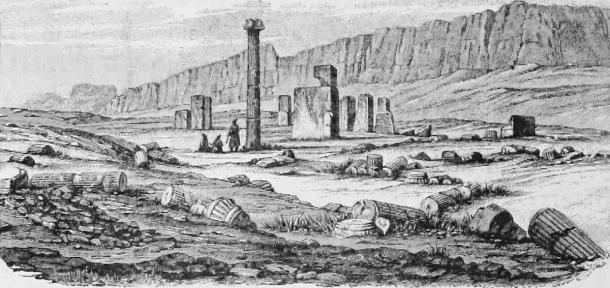
A drawing from the ruins of Istakhr in the 19th century (Public Domain)
4. The Extermination of the Druids in Britannia
By the middle of the first century AD, the Romans were pretty well established in what is now the United Kingdom, but not everything was going to plan. In particular, the Welsh tribes had proven themselves to be a nuisance, difficult to put down. Roman patrols and trade caravans were constantly being attacked by small bands. The Romans couldn’t afford to put up with any kind of native rebellion. The Roman leader in Britannia, Suetonius Paulinus soon had enough of these guerilla tactics. An example had to be made.
He sent his troops to the island of Mona, which is called Anglesey today. This island was the sacred home of the Druids, as well as several Welsh tribes. The Romans set about making sure the Druids would become a thing of history.
Men, women, and children were put to the sword by Roman infantry and cavalry. Their corpses were dumped on vast bonfires. The slaughter began with the Welsh tribesmen who had set out to protect their families and holy men. While they had previously been successful as guerillas, they didn't survive long in open combat against the highly trained and disciplined Roman legions.
After the tribesmen had been dealt with, the troops turned their attention to the peaceful Druids. The Druids had put up no fight, but the Romans were a superstitious lot. They feared the Druid's pagan beliefs and thought it better to slaughter them, just in case.
After all the Druids were dead, the Romans set about destroying any trace that they had ever existed. A garrison was built on the remains to deter any future rebellion from the surviving locals.
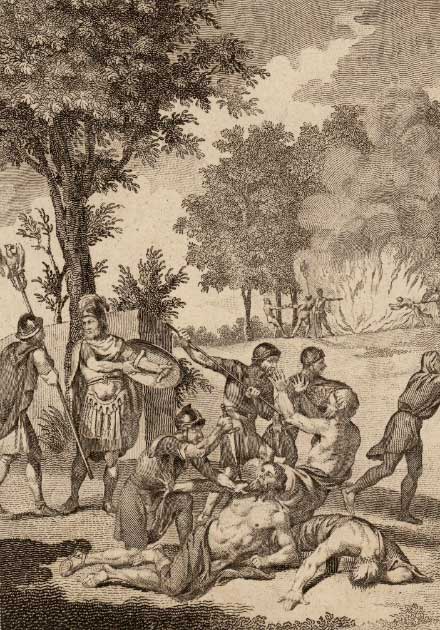
Detail of illustration showing Roman soldiers’ massacres of the Anglesey Druids, as described by Tacitus. (Public Domain)
5. The Male-Only Massacre of Hysiae
The Peloponnesian War of 431-404 BC between the Athenians and the Spartans was a nasty one, full of bloody battles. One such battle was the Battle of Hysiae, fought between the armies of Sparta and Argos in 417 BC.
The Athenians had been determined to establish a democratic government just like their own in Argos. The Spartans invaded Argos after some of their supporters had been evicted from Argive territory. The Spartans, led by King Agis II, did not manage to take the city, but they did manage to take a nearby fortress city, Hysiae.
Agis II still had his sights set on Argos. He ordered that the male population of Hysiae be rounded up and taken hostage. If the Athenians agreed to hand over Argos, he would spare his hostages. He presumed the civilized Athenians would have no choice but to agree.
Unfortunately, the Athenians were more stubborn than Agis had accounted for. He was left in an awkward position. The Athenians refused to back down, and they had fortified Argos to a degree that he stood no hope of taking the city by force. At the same time, he had saddled himself with thousands of hostages who were eating up his supplies.
Agis decided he had only one choice, to withdraw from the area. The problem was, if he allowed the hostages to live, he would look weak. The Athenians would have called his bluff. So Agis ordered that his hostages be executed. Every male resident of Hysiae, no matter their age, was massacred. The exact number of deaths remains unknown to this day.
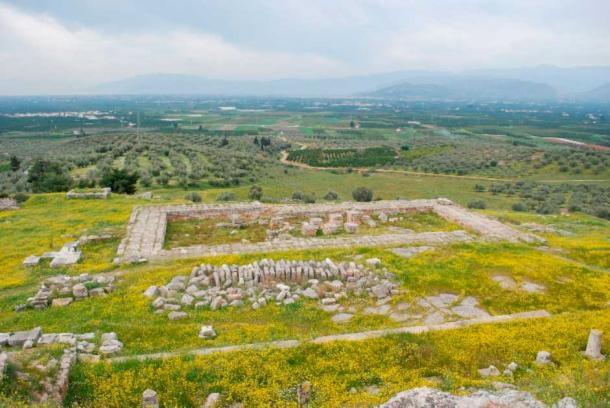
The Spartan king Agis II ordered the massacre of all men from Hysaiae in ancient Argos. View from the Heraion of Argos into the Inachos plain, Argolis, Greece (Sarah Murray / CC BY SA 2.0)
6. The Alleged Massacre of the Jews at Banu Qurayza
People have been blaming religion for their brutal misdeeds for millennia. When the Prophet Muhammad ordered his attack on Banu Qurayza, he claimed he did so at the insistence of Archangel Gabriel.
Supposedly, the angel had told the prophet that the Jewish tribe that lay within the fortress must be wiped out. This was awkward for Muhammad, as he had agreed to a peace treaty with the Jewish occupants.
Historically, it seems that the Jewish residents had broken their treaty with the Muslims after being pressured to do so by other local Jewish tribes. Muhammad’s followers responded by going in and attacking the fortress. The siege lasted roughly three weeks.
After three weeks, the Muslims were victorious and their leader, Sa’d ibn Mu’adh, ordered that the surrendering Jews should be taken into custody. They needed to be punished for opposing God's will.
It was ordered that all the men be killed, and the Jews property be divided between the victors. The women and children were taken as ‘captives’. Captives was a nice way of saying slaves.
The male captives were rounded up and stripped. If they were found to possess pubic hair they were separated from their brothers and beheaded. The exact number of men killed at Banu Qurayza is unclear. It is most commonly cited that between 600 and 900 men were killed.
Some Islamic scholars have disputed this number, and whether the massacre ever occurred at all, citing it as Jewish propaganda. Jews and western scholars on the other hand have pointed to parts of the Quran and contemporary sources that appear to indicate the massacre happened.
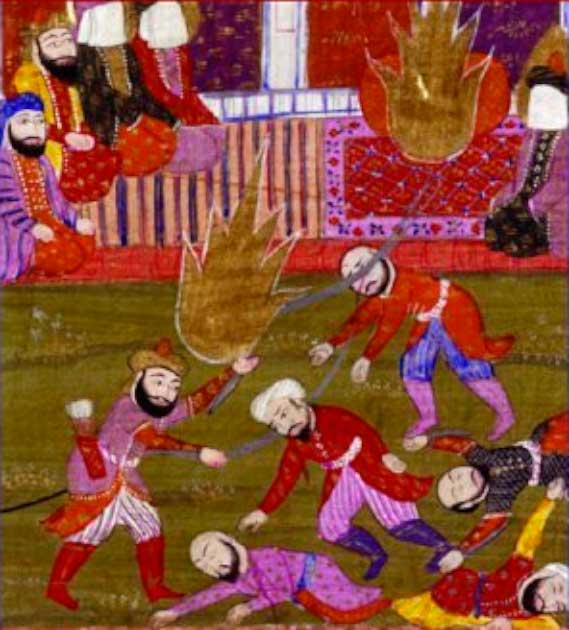
Detail from miniature painting ‘The Prophet, Ali, and the Companions at the Massacre of the Prisoners of the Jewish Tribe of Beni Qurayzah’, illustration of a 19th century text by Muhammad Rafi Bazil. (Public Domain)
7. The Mass Slaughter of the Third Jewish-Roman War
It is no secret that the Jews and Romans didn’t exactly get along. What is often forgotten today is just how bad things were. The Third Jewish-Roman War centered on a Jewish revolt in Judea between 132- 136 AD. The Jews were led by Simon Bar-Kokhba, who had proclaimed himself the Prince of Judea and whose followers believed him to be a messiah.
Simon used this belief to empower his followers. At the start, it worked, and the Jews fought well during the beginning of the war. The Romans faced more military defeats than they were used to. The Jews had their gloves off and were readily massacring any Roman troops they managed to capture.
When Emperor Hadrian heard how badly his men were doing, he dispatched strong reinforcements to the region. Their arrival in 134 AD was a turning point for the war. What followed was a massacre, as Jewish troops and civilians alike were crushed by the Roman troops. Entire towns and cities were wiped off the face of the planet.
It is estimated that at the beginning of the war, the Romans faced casualties of roughly 100,000 men, but some sources put the number at almost twice that. The Jews ultimately fared much worse. It is estimated that around 580,000 Jews were killed during the war. At least 400,000 of these deaths were during battle or from execution as prisoners of war. The remaining 180,000 were innocent civilians.
This isn’t a clear-cut case of Jews=good, Romans=bad, however. Many of the civilians who were killed died at the hands of Bar-Kokhba’s followers. Jews who refused to take part in the revolt were tortured and executed by their people. Greek and Roman civilians were also persecuted and massacred by Bar-Kokhba’s followers during the war.
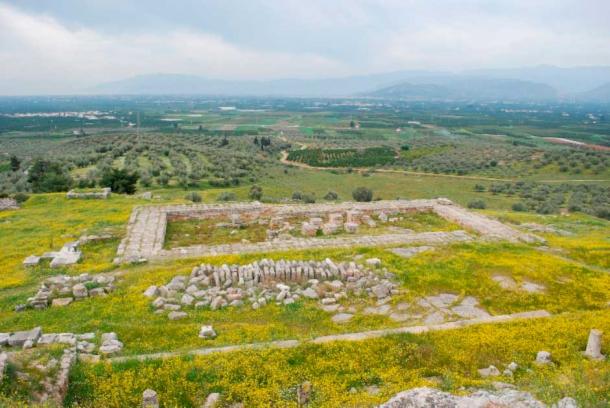
Ruined walls of the Beitar fortress, the last stand of Bar Kokhba Revolt and massacre of Jews by Romans and other Jewish people alike (Bukvoed / CC BY 4.0)
Conclusion
The brutality with which these massacres were carried out is awful and the lack of humanity terrifying. Whether it be for religious, political, or other reasons, humans have always been adept at finding excuses to massacre each other.
Most shocking, however, is the fact we haven’t changed. If anything, people have just gotten better at it. It used to take time and effort to massacre a few thousand people. Now, all it takes is a few bombs or a handful of carefully placed air strikes. We can condemn the ancients for carrying out such atrocities, but the sad truth is many of us turn a blind eye to similar atrocities every day.
Top Image: Massacres have been a near constant in human history. Pieter Bruegel the Elder painting The Triumph of Death, circa 1562. Source: Public Domain
By Robbie Mitchell
References
Carradice, P. 2013. The Death of the Druids. BBC Wales. Available at: https://www.bbc.co.uk/blogs/wales/entries/375ec5d4-a10c-3f1a-929c-12d9697f3f58
Gernet, J. 1996. A History of Chinese Civilization. Cambridge University Press. Available at: https://books.google.com.bd/books?id=jqb7L-pKCV8C&printsec=frontcover#v=onepage&q&f=false
Gibbon, E. 1789. The History of the Decline and Fall of the Roman Empire. Available at: https://books.google.com.bd/books?id=aLcWAAAAQAAJ&printsec=frontcover#v=onepage&q&f=false
Mulligan, R. 2013. Genocide in the Ancient World. World History Encyclopedia. Available at: https://www.worldhistory.org/article/485/genocide-in-the-ancient-world/
Warner, R. 1985. Thucydides, History of the Peloponnesian War. Penguin.
















Comments
An article about massacres shouldn’t be complete without mentioning the atrocities done by the Mongols as they rampaged across Asia and Europe, as well the genocide done by Muslim invaders of India against the local Hindu population over a period of about 800 years.
How does the Roman sack of Corinth not make this list? At the final battle, all men were killed and the rest (women, children and the elderly) were enslaved. Many tens of thousands perished in total.
Nobody gets paid to tell the truth.